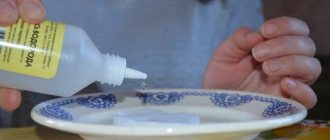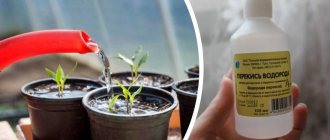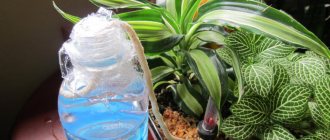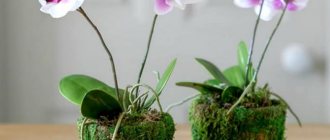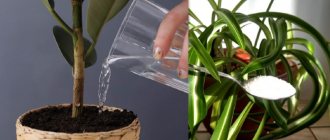One of the means for watering indoor flowers, which will help them bloom magnificently and for a long time, is hydrogen peroxide, diluted with water in the required proportion.
Dear readers!
For you, we have created communities on social networks in which useful articles and interesting ideas are published several times a day! Subscribe and receive useful content in a convenient format! Peroxide is available in almost every home, it is effective and practically harmless.
In this article we will tell you how to properly dilute hydrogen peroxide for watering indoor flowers, and also explain some of the nuances and subtleties of working with the substance.
What does hydrogen peroxide give to flowers and plants?
The chemical formula of water is H2O, and hydrogen peroxide or peroxide is H2O2 , i.e. one more oxygen atom for the same number of hydrogen atoms. It is the “extra” oxygen that is due to the main property of the substance – oxidation.
Due to the instability of the connection, upon contact with the ground, the oxygen atom goes into a free state. At the same time, the vital activity of microbes, as well as harmful microorganisms located in the soil, freezes. The process helps enrich the soil with oxygen and disinfect it.
Watering indoor flowers with peroxide water leads to:
- getting rid of harmful microorganisms that inhibit development and flowering;
- slowing down the process of root rotting;
- acceleration of bud formation and flowering;
- soil fertilization.
When foliage is damaged, hydrogen peroxide is used as a disinfectant.
Chemical properties and composition of peroxide
Hydrogen peroxide is widely used in medicine. The active substance of this drug is hydrogen peroxide. The main difference between peroxide and ordinary water is the presence of an extra oxygen atom, which is quickly detached. This drug is in every medicine cabinet due to the fact that it has powerful antibacterial properties and belongs to the group of oxidants. So, it is used in first aid to treat wounds, cuts and stop bleeding.
Bactericidal properties of peroxide
Due to the release of free oxygen, the substance helps to destroy microbes on the surface of the skin and cleanse damaged and dead particles. The formation of foam accelerates the process of blocking damaged vessels and stopping bleeding. However, the medicine has only a temporary effect and does not completely sterilize the wound surface.
For which indoor flowers is hydrogen peroxide a top dressing?
Hydrogen peroxide is found in rainwater, which indoor plants love so much. Therefore, peroxide is suitable for watering any indoor flowers.
IMPORTANT! For the use of a substance to be beneficial, its proportion in the working solution must be low. Otherwise you will harm your indoor flowers.
If for blooming and decorative flowers in good health, hydrogen peroxide is a good help for healthy growth and flowering, then for sick, wilting crops it is also a means of resuscitation.
Hydrogen peroxide can also be used for soaking seed material, treating the root system before transplanting or picking seedlings.
There is one caveat. Peroxide should be used with caution for watering domestic flowers with double leaves and inflorescences. For example, you cannot spray them, because this can lead to the onset of putrefactive processes.
You should also refrain from treating succulents, especially cacti, with hydrogen peroxide. These indoor pets are already very capricious in terms of watering. If you need to feed them, it is better to give preference to special complex formulations for succulents.
But orchids, aroids and arrowroot crops are very fond of watering with peroxide. All these are guests from the tropics, where tropical downpours often occur, so it is recommended to periodically water orchids, arrowroot, spathiphyllum, and anthurium with this product.
What is peroxide used for: watering plants and more
The mechanism of “work” of peroxide is simple: the formula is not stable and the substance in the form of an aqueous solution quickly disintegrates into water and free oxygen. Free oxygen atoms saturate the soil with the necessary gas, kill harmful bacteria and other pathogens, fight rot, fungus, mold and pests at all stages of their development, stimulate the root system to more actively function and absorb nutrients. Water helps the soil to become saturated with moisture, which is necessary for dissolving nutrients and absorbing them by the roots. Thus, the composition of the soil improves, plants are able to more actively absorb food and water, in addition, they are protected from pests and pathogens, and therefore better reveal their potential: they grow more actively, gain green mass, have a beautiful exterior, bloom more abundantly and longer, bear fruit better. Of course, indoor flowers in pots require periodic fertilization, but since nutrition is absorbed better and completely, the dose can be reduced, thereby even reducing the cost of caring for green pets. In addition to adding hydrogen peroxide to the root zone with watering, the same aqueous solution can be used to spray leaves and stems for preventive, protective, and medicinal purposes. Another direction for using the substance is preparing seeds before planting. Soaking the seed or dipping the root of a seedling or cutting for several minutes before placing it in the ground in a peroxide solution allows you to soften the dense shell of the seeds, start bioprocesses and disinfect, preventing the development of a particular disease.
When can fertilizing be applied?
For young flowers, seedlings and individual seedlings, the peroxide mixture helps strengthen the root system and increases disease resistance.
Watering flowers with this fertilizer is especially useful during the growing season, when rapid growth and development occurs.
Fertilizing can be applied in combination with other natural fertilizers: sugar, honey, banana peels, etc. Watering with the solution is carried out the day before or after applying the main fertilizer.
Feeding seedlings during diving strengthens and protects their root system.
Is it possible to water flowers?
Hydrogen peroxide has a positive effect on many living organisms, including flowers. In nature, plants receive water after rain and when snow melts. This is the chemical composition of water that is ideal for indoor flowers, and it can be obtained thanks to hydrogen peroxide. This diluted product can be used to irrigate young seedlings and indoor plants, disinfect seeds before planting in the ground, and spray seedlings.
Experienced flower growers claim that already an hour after peroxide gets into the ground, you can notice a positive result. The plant begins to grow much faster, the green mass increases and subsequently fruiting increases. In addition, hydrogen peroxide is recommended for treating plants during their growth, as it effectively fights various types of diseases.
How to use peroxide for flowers
Watering indoor plants is often done with tap water, which contains calcium and magnesium salts. Such hard water negatively affects flowers. Therefore it is softened.
For this purpose, make a mixture of 3% hydrogen peroxide and water in various proportions. The concentration of the mixture depends on the purpose for which it will be used: watering, spraying, treating seeds and seedlings, etc.
ATTENTION! The main ingredient is hydrogen peroxide, the concentration should be 3%.
The condition of the plant and soil is an important factor when watering with this product.
Improper use of the drug can cause damage to flowers, sometimes irreparable.
How to feed geraniums with peroxide?
Geranium is a stunning houseplant that produces beautiful flowers. Peroxide in this case is used to stimulate growth, as well as to protect against fungi and bacteria. It helps strengthen the immune system.
How to feed geraniums with peroxide:
- To feed this plant, you need to know the concentration of the solution. Be sure to choose rain or well water; filtered water is not suitable, as it does not contain any trace elements and minerals.
- To water the plant, you need to dissolve 40 ml of peroxide in 1000 milliliters of water. Treatment must be carried out in the morning and evening. Before fertilizing, it is recommended to water with plain water to moisten the soil. This helps to get rid of possible burns and unpleasant consequences.
Fertilizers
How to water with a solution: proportions and step-by-step instructions
Using the drug, water is purified from impurities and chlorine. The watering solution is prepared at the rate of 1 tablespoon of hydrogen peroxide per 1 liter of water. Water once every 5-7 days. For regular use, just add 2 drops of the product to a liter of water.
It is first necessary to clear the surface of the earth from fallen leaves and debris to avoid the development of rotting. The watering process is carried out as follows:
- purchase 3% hydrogen peroxide at the pharmacy;
- measure out 1 liter of settled lukewarm water;
- add the required amount of the drug to the water, mix thoroughly;
- moderately water the indoor flower. The proportion of added liquid must be calculated in accordance with the size of the home flower.
The water should flow along the edge of the pot so as not to erode the soil near the root.
The second recipe is with sugar. In addition to oxygen, home flowers will receive glucose, which will help plants grow and develop better.
The fertilizer should be prepared according to this recipe:
- Stir half a glass of sugar into 100 ml of hydrogen peroxide. It is necessary to bring the mass to a homogeneous consistency.
- Pour the mixture with 2 liters of warm water. Stir thoroughly.
- Water the plants, calculating the proportions in accordance with the size of the home flower.
The drug can also be used to moisten the soil daily, but then the proportions will be completely different.
Only 3 drops of the drug are needed per liter of warm, settled water.
If you are planning to replant an indoor flower, you can saturate the soil with oxygen by using the following mixture: 1 liter of water + 6 ml of hydrogen peroxide.
Hydrogen peroxide for indoor plants: methods of application
It is recommended to use peroxide during transplantation to treat the roots. As soon as you notice that the plants are starting to wilt, we recommend replanting them in new soil and pot.
Hydrogen peroxide for indoor plants, methods of use:
- You can use the old one, but first wash it with a lot of soda and pour boiling water over it. In addition, an antiseptic can be used to eliminate pathogenic microorganisms that remain on the walls of the vessel.
- Next, you need to thoroughly rinse the roots of the plant, remove damaged areas, black areas, and soak in the solution for 15 minutes. To do this, you will need 20 ml of 3% peroxide per 1000 ml. Only after this is transplantation into a new flowerpot carried out.
- Peroxide contains a large amount of nutritional components and has a good effect on the condition of the soil. Therefore, it is recommended to water once a week with a weak solution. To do this, 15 ml of 3% peroxide is dissolved in 1000 ml. Under no circumstances leave this liquid standing; after just a few hours it loses its properties, as oxygen evaporates and hydrogen along with it. Accordingly, water becomes the most common and does not have universal properties. It becomes absolutely useless for feeding.
- Hydrogen peroxide is widely used to treat bulbous plants. When transplanting to open ground or into a pot, it is necessary to soak the bulbs in the prepared solution for 30-40 minutes. It is necessary to dissolve 10 milliliters of the prepared product in a liter of water and mix. Remember, the solution should be at room temperature or slightly warmed. Be sure to remove all scales, dark spots, and places that have begun to rot from the surface of the bulbs.
Spraying
How to spray flowers with a solution, how to dilute it?
In winter, when the air in the apartment is dry, after moistening, the color of the foliage becomes bright and saturated. For spraying, use the same composition as for watering: 1 tablespoon of peroxide per liter of liquid. For effectiveness, it is recommended to add a teaspoon of sugar.
Sick plants are sprayed with a mixture: 2 tablespoons of the drug per liter of water + 2 drops of iodine, and to control pests, alcohol is added instead of iodine.
Also, a solution with added iodine is used to control pests (scale insects, aphids and mealybugs).
The recipe is as follows: 0.5 liters of water, 1 teaspoon of peroxide and 10 drops of iodine. Everything is thoroughly mixed and poured into a spray bottle.
Hydrogen peroxide and alcohol, mixed in a certain proportion, will rid your home flowers not only of pests, but also of diseases.
The working solution is prepared as follows: 0.5 liters of water, 25 ml of peroxide and 10 ml of medical alcohol. Spraying is carried out every day for a week.
First spray the underside of the leaves, then the top. We must try to moisten the stems and shoots, and also ensure that moisture does not get on the flowers and buds.
IMPORTANT! You cannot spray plants with velvety, translucent and thin leaves: violets, caladium, pelargonium, etc.
Breeding rules
A solution for indoor flowers based on peroxide is prepared depending on the purpose and concentration of the starting substance; the proportions may vary.
Initial concentration 35%: prepare a 1% solution by adding 10 ml per 1 liter of water. In this case, the drug will promote rapid aeration, and it will begin to act within a few hours after treatment. This will become clear from the appearance of the plants in a couple of days to a week.
Initial concentration 3%: 20 ml of reagent dissolved in 1 liter of water.
You can add 30 g of sugar to both formulations to nourish the cells.
Basic cooking rules:
- Use gloves when working with 35% reagent. It can cause burns on the skin that become white and have superficial necrosis.
- Do not inhale vapors when working with this substance to avoid burns to the upper respiratory tract. It is also better to protect your eyes from fumes with special glasses.
- After adding, stir the solution thoroughly with a stick to average the concentration.
Since the released oxygen quickly leaves the solution, it must be prepared just before use. Storage even for a couple of hours deprives it of all its beneficial properties.
Advantages and disadvantages of hydrogen peroxide
The use of the drug, subject to all rules and regulations, gives good results in caring for indoor vegetation. With its help you can cope with diseases, pests, and feed flowers. Peroxide serves to stimulate growth and flowering.
But positive properties can turn into negative ones.
When the proportions in the solution are not respected, the roots can be burned, or the leaves will begin to become stained.
If watered too frequently with the solution, an indoor flower may lose its natural immunity, and then it will not be able to independently protect itself from diseases. As a result, the flower grows “spoiled,” which is contrary to nature.
Feeding and fertilizer
Thanks to hydrogen peroxide, it is possible to keep the roots of indoor flowers and seedlings healthy and attractive.
Watering
A positive result can be achieved through additional aeration, which helps the plant quickly absorb macro and microelements. When hydrogen peroxide gets into the ground, oxygen is released, which absorbs dead roots and thereby prevents the proliferation of various pathogens. It is recommended to simply stir 10 ml of peroxide in 1 liter of water and water your indoor plants with this nutrient mixture once a week.
When adding peroxide to the soil as a fertilizer, there is no need to resort to other fertilizers. The fact is that this product contains all the necessary microelements that are needed for normal plant growth and flowering. When using other types of fertilizers, the soil may become oversaturated or the flower will simply become spoiled.
Hydrogen peroxide also helps to cope with plant diseases such as root rot and blackleg. Typically, rot on the roots appears within a day when the plant is flooded with water and the roots are in stagnant water with insufficient oxygen content. In this case, it is recommended to water such plants with a solution prepared from phosphorus fertilizer and 3% hydrogen peroxide. It is necessary to add 20 ml of H2O2 to the fertilizer solution and treat the plant with this mixture twice a week.
Spraying
In addition to watering, it is allowed to spray the plants. It is recommended to perform this procedure several times a week, while not forgetting to lift the leaves of the flower. Spraying must be done from the outside of the plant, being sure to pay attention to the stems. Constantly performing this procedure helps indoor flowers maintain their attractive appearance for a long time. Gradually, the leaves become bright green, and weak shoots take on new life. Hydrogen peroxide is considered effective in combating fungal diseases such as blackleg, mold and root rot.
At home, you can prepare a prophylactic agent with the addition of hydrogen peroxide, which needs to be sprayed on the flowers every day. The following components are used for this solution:
- 900 ml water;
- a few drops of dishwashing detergent;
- 20 ml medical alcohol;
- ¼ cup 3% hydrogen peroxide.
The mixture for spraying plants must be prepared before use by mixing all the components together. It is recommended to irrigate the stems and leaves of plants with this product with the addition of hydrogen peroxide, which helps protect them from various pests.
How does the substance affect the plant?
The drug has bactericidal and disinfectant properties and for vegetation it is:
- growth and flowering accelerator;
- medicine against diseases;
- a means to combat harmful insects;
- immunostimulant;
- disinfectant.
The substance in the correct proportion is harmless, therefore it does not poison plants with chemicals. When a flower is weakened or damaged, the peroxide solution acts gently, without the risk of harming the already withering plant.
REFERENCE. Hydrogen peroxide is an effective remedy that helps in caring for indoor plants. Its correct and timely use has a beneficial effect on flowers. Watering with this preparation does not require any special skills and can be done even by inexperienced gardeners.
Purpose and subtleties of application
Spraying foliage
Treating flowers with hydrogen peroxide significantly improves their appearance. Plants especially suffer during the heating season, when the air is dry and the frost outside the window does not allow ventilation. After irrigation, the color of the leaves becomes rich and bright.
The composition of the solution has a beneficial effect on all parts of the plant that are infected with pathogenic bacteria.
Irrigation method:
- For spraying flowers 1 tbsp. l. hydrogen peroxide is diluted in 1 liter of water.
- Before use, you should rid the plant of affected leaves and dry branches.
- It is necessary to remove the top centimeter layer of soil.
- Spray the shoots of the plant, then the underside of the leaves.
- Process the leaf blades from above.
- Avoid getting the solution on the buds of flowering plants.
- Irrigation should be carried out early in the morning so that the plant has time to dry.
- During the cold season, you should not leave wet indoor flowers on a cold windowsill.
Watering
If the plant's roots do not receive enough oxygen, the root hairs begin to die. The plant is withering, and an inexperienced gardener, in an effort to revive the green pet, waters it. Water displaces the remaining oxygen from the soil, and it is unlikely that it will be possible to save the plant.
Watering with a hydrogen peroxide solution is useful for indoor flowers.
Hydrogen peroxide as a fertilizer for flowers and plants, when combined with water, releases active oxygen, which allows the roots to breathe:
- proportions of composition for watering flowers: 1 tbsp. l. 3% percent hydrogen peroxide per 0.5 liters of water.
- water with the solution once every 5 days, not more often.
Root fertilizer
When feeding flowers with hydrogen peroxide, plants better absorb nutrients from oxygen-enriched soil. It is not recommended to use other fertilizers together with peroxide. The risk of oversaturation of plants with minerals increases.
For flowering plants, this will stop budding due to the growth of green mass.
How to feed indoor flowers with hydrogen peroxide:
- proportions of the composition for watering: 4 tbsp. l. 3% peroxide per 2 liters of water;
- water with the solution once every 5 days, not more often..
Pest protection
The bactericidal use of hydrogen peroxide is due to its oxidizing properties. Plants weakened by improper care become easy prey for harmful insects.
Scale insects, aphids, spider mites - this is not a complete list of pests. Some of them are so small that their presence can only be guessed by the deterioration of the flowers. As a result of the activity of pests, shoots and leaves become covered with microcracks on which fungus can form.
Spraying plants with a solution of hydrogen peroxide will get rid of insects
Feeding with added iodine will help get rid of annoying insects and bacteriosis:
- Disinfectant solution for treatment and prevention consists of 2 tbsp. l. 3% hydrogen peroxide, 30-40 drops of iodine and a liter of water.
- It can be used once every 5 days for watering or spraying.
Seed treatment before sowing
The powerful oxidative reaction of hydrogen peroxide is used to prepare seeds for sowing. A 3% solution destroys pathogenic bacteria that may be on planting material.
Some seeds contain a lot of essential oils, which makes germination and germination difficult. When such planting material is soaked in a solution of hydrogen peroxide, essential oils easily dissolve. The seeds sprout vigorously.
Peroxide acts on seeds and as a growth stimulator. Young plants whose seeds were soaked in the solution have increased immunity.
Treating seeds with a solution of hydrogen peroxide before sowing will enhance their growth
Seeds are soaked according to two schemes:
- Option 1. Place the seeds in undiluted 3% hydrogen peroxide and leave for 15-20 minutes. After this, the seeds must be washed and dried. Suitable for preparing seeds with a dense shell for sowing.
- Option 2. Dilute 3% peroxide with water at the rate of 1 tablespoon per 500 ml of water. Place the seeds on cotton pads soaked in the solution. Leave for 12 to 24 hours, depending on the density of the seed shell. There is no need to wash the seeds, just dry them.
Common Mistakes
Often, beginning flower growers, in order to save money, leave the prepared mixture for the next use.
ATTENTION! The hydrogen peroxide mixture is prepared immediately before watering and will be used immediately. Unused residue quickly decomposes, losing its beneficial properties.
Another mistake is the incorrect proportion of solution components. Exact adherence to proportions guarantees the beneficial qualities of the drug.
Next error: the concentration of the solution does not correspond to the purposes for which it was prepared.
For example, a mixture is prepared to treat a plant, and is used for regular watering.
Precautionary measures
Hydrogen peroxide is not an overly aggressive chemical. Using the solution, it is difficult to harm plants. Peroxide quickly breaks down into oxygen and water, so an overdose is practically impossible.
In order not to harm indoor flowers, you should:
- use a solution of exactly the recipe that is suitable for the type of work being carried out;
- to treat home flowers, use hydrogen peroxide in precise dosage;
- use freshly prepared solution. The process of decomposition into its component parts - water and oxygen - occurs quickly, and during storage the solution loses its beneficial qualities;
- If whitish spots resembling mold appear on the surface of the soil, the use of peroxide should be abandoned until the spots completely disappear.
Answers to frequently asked questions
Is it possible to water indoor flowers with hydrogen peroxide?
If in doubt, you can conduct an experiment: water one flower. When you get satisfactory results, all doubts and fears will disappear.
What diseases can be treated with hydrogen peroxide?
Based on the bactericidal and antiseptic properties of this product, fungal diseases and mold damage can be cured.
The initial stages of the disease are treatable. At the same time, peroxide is a powerful preventative against these diseases.
What colors can it be used for?
The composition of peroxide resembles rainwater enriched with ozone during a thunderstorm. If you remember how cheerful the plants in the garden look after a summer rain and thunderstorm, you can assume that such moisture will not harm indoor plants either.
Inexperienced plant growers are wary of any chemical compounds, so they may have doubts about the harmlessness of hydrogen peroxide and whether it is possible to water indoor flowers with it.
A single watering of the least valuable flower with a solution will help dispel doubts. A satisfactory result will remove all questions and concerns.
But not all indoor plants benefit from dousing. Plants with velvety (violet), translucent (caladium) or thin (pelargonium) leaves should not be moistened. They do not tolerate high humidity well. It is better to water them at the root or use bottom watering in a tray.
Almost all flowers benefit from fertilizing with hydrogen peroxide.
Preparation of the solution
Important rules:
- use hydrogen peroxide 3%;
- do not exceed the norm of the pharmaceutical product for a specific operation: watering, fertilizing, spraying, disinfection, destruction of rot;
- Take water that is not very warm, but cold liquid is also not suitable;
- do not prepare too large a volume of peroxide-based solution: one serving – no more than 1 liter.
Note! The proportions depend on the type of operation: for daily watering, take no more than 1-2 drops of peroxide per 1 liter of liquid, and when soaking seeds for disinfection before planting, use an undiluted pharmaceutical product.
Useful properties of the substance for indoor plants
Many gardeners use proven folk remedies to care for ornamental plants. Hydrogen peroxide, judging by reviews, is on the list of popular substances for solving various problems when growing flowers.
Beneficial features:
- prevents the development of rot;
- disinfects the aboveground and underground parts of plants and soil;
- accelerates the release of buds;
- serves as fertilizer;
- reduces the risk of developing bacterial infections.
For seeds and seedlings
If it is necessary to treat seeds, hydrogen peroxide can be replaced with such a traditional remedy as potassium permanganate. To disinfect seeds, you need to soak them for half an hour in a 10% solution, then rinse well with water and dry. If you are sure that there are no pathogens in the plants, it is allowed to use hydrogen peroxide as a growth stimulant. In this case, the seeds should be soaked in a 0.4% hydrogen peroxide solution for 12 hours. It is recommended to soak hard-to-germinate seeds of parsley, beets or carrots in the solution for two days.
The seeds will germinate much faster, and the seedlings will have strong roots, if they are left for some time in a 3% peroxide solution. To prepare such a solution, you need to dissolve 30 drops of 3% peroxide in a glass of water. This product helps to quickly soften the seed shell and destroy pathogens living on their surface.
After picking the seedlings, it is recommended to spray them daily with a solution of hydrogen peroxide. This product saturates the leaves with additional oxygen, and the seedlings grow much better. To prepare the mixture, you need to dissolve a bottle of 3% hydrogen peroxide in two liters of water. This product must be sprayed on the leaves of the seedlings or watered at the roots. The solution disinfects the soil and helps protect seedlings from various pests.
In some cases, when using a hydrogen peroxide solution, white spots that resemble mold may form on the surface of the soil. This is most often observed when using land purchased in a store, and in such a situation it is better to spray young shoots without watering.
Hydrogen peroxide - a recipe for healthy seeds
oteplizah.ru
If you don’t have potassium permanganate or a store-bought preparation on hand, you can successfully disinfect the seeds using hydrogen peroxide. It destroys bacteria and fungi. As a result, the treated seeds grow into plants with strong immunity, which are less likely to be affected by diseases.
Hydrogen peroxide will also soften the seed coat and speed up germination. The germination rate of tomatoes after treatment can reach 90%, corn - 95%. And if you soak cabbage seeds in peroxide, the first sprouts will appear a few days earlier than usual. It is especially useful to use the product for hard-to-germinate seeds of zucchini, pumpkin and peppers.
To pickle the seeds , pour them with a 10% peroxide solution for 15-20 minutes. Then rinse with clean water and dry.
To stimulate germination, dilute 1 tbsp. 3% peroxide in 500 ml of water and immerse the seeds in the liquid for 12 hours, for hard-to-germinate seeds - for a day. The solution must be changed every 4 hours so that the seed does not suffocate and die.
Metal containers cannot be used to soak seeds in hydrogen peroxide, because the metal will oxidize. Also, do not use the product together with other drugs to prevent the occurrence of dangerous chemical reactions.
Why and in what cases is it used?
Hydrogen peroxide solution is used for spraying and watering many indoor flowers. Before the first use, you need to carefully study the rules for preparing the compositions, find out the proportions so that the product is not too concentrated.
Proper treatment of affected plants or the use of a pharmaceutical product for preventive purposes preserves the strength and strength of flowers and solves many problems. Many gardeners confirm that peroxide has a positive effect on plants and soil.
Indications for the use of formulations based on hydrogen peroxide:
- root rotting;
- a bacterial infection has been identified;
- mold appears on the ground;
- the flower grows weaker.
